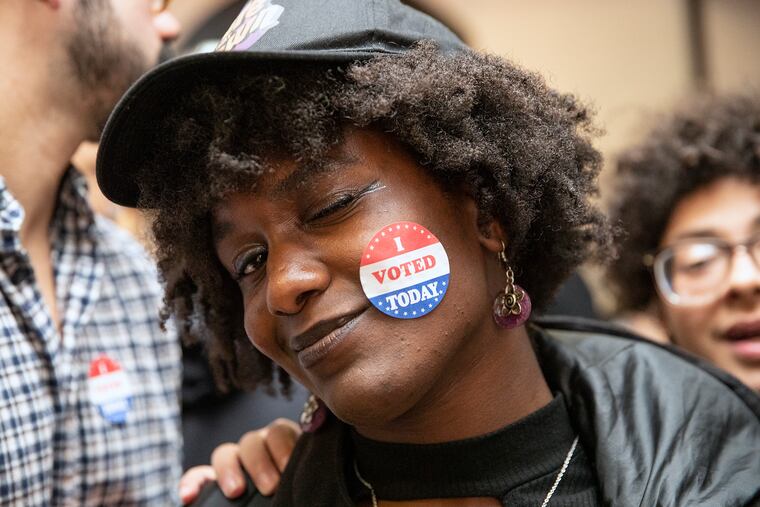We’re seeing more women in politics. Is it a quick ‘wave’ or a lasting trend? | Opinion
My research suggests the women of 2018 represent the vanguard of a gender-equal General Assembly.

Coming off the Nov. 5 election, I am prompted to reflect on a feature of our politics that is both a significant challenge and a source of optimism: gender representation. There is a dramatic deficit in the relative number of women in elected office, in Pennsylvania and nationwide, and 2018 saw a record number of female candidates. But was this a lasting change that may help rectify this imbalance, or a fleeting reaction? In studying this phenomenon, I found heartening evidence: Recent increases in female candidacy look more like a trend than a wave.
“Wave” is an awesome and formidable term of art in politics. It describes a powerful surge of public support for a party, interest, or faction, with the power to sweep a great many candidates of like mind or kind into office. However, it should also be noted that — in politics as in nature, a wave is temporary a thing. In addition to rising, cresting, and sweeping to shore, it crashes and recedes. Thus, a surge in the number of women running for (and winning) public office in 2018 is an inspiring sight, but if it is a wave, then proponents of representational equality ought not to cheer.
Waves are good, but they are not necessarily progress. We have seen similar waves before, only to witness them followed by a regression to the quite-unrepresentative mean — only about a quarter of the seats in the General Assembly are held by women, even after the 2018 wave. Far better than a wave would be a trend: a general, rising tide of interest and support, at the end of which gender ceases to be a reliable predictor of electoral representation and success.
This was the very question I investigated: Was 2018 a wave, or the start of a trend?
To start, I considered what would signal a difference. The short version is that the difference between a wave and a trend is that a trend has an underlying feature not present in a wave: a consistent, motivated supply of female candidates. Translated into measurable terms, this would mean that in a long-term trend, there should be a noticeable increase in recruitment of female candidates (either formally, by political actors, or informally, by friends and family) as well as expressions of a longer-term desire to remain politically engaged by the candidates themselves.
If the record-setting number of women running in 2018 were largely self-recruited and short-term motivated, then it is a phenomenon that is unlikely to repeat in future years — a wave, not a trend. If they were actively recruited and are electorally engaged thereafter, then the wave would be less likely to recede. Forecasting is ever a dangerous business, but a survey I conducted of 119 female candidates in the 2018 election cycle yielded highly encouraging signs.
More than three-quarters of respondents indicated some level of recruitment, with two-thirds being formally recruited by a party leader or activist and one-third responding to encouragement by their peers to seek out opportunities to serve (and then being guided into a run by the party).
Literally all respondents indicated they would recruit others to run in future elections, which suggests that far more women will be recruiting candidates for office in the future.
This is encouraging in that traditional candidate recruitment has a significant male selection advantage. Female candidates are often recruited as “sacrificial lambs” in unwinnable races, rather than genuine candidates, or running wildcat independent candidacies. In 2018, record numbers not only ran, but were encouraged to run (in winnable races) by traditional party leaders and activists.
It was in the survey’s persistence measures — questions that solicited interest levels in continuing to stand for office and encouraging others to do so — that we find the most cause for trend optimism. Candidates indicated they planned to run for reelection (assuming a victory) by a 3-to-1 margin, and more than half planned to run again even after a loss.
Literally all respondents also indicated they would recruit others to run in future elections, which strongly suggests that far more women will be recruiting candidates for office in the future. While they will obviously not recruit women exclusively, previous research suggests that gendered, male-preferential recruiting is far more common when men are the predominate recruiters. A more gender-balanced recruiting body should yield a more gender-balanced slate of candidates moving forward.
Whether the women of 2018 represent the vanguard of a representative, gender-equal General Assembly is impossible to state with certainty, but we should not be surprised if this wave is, in fact, a tide.
Joshua J. Weikert, Ph.D. is an assistant professor of politics in the Department of Civic Engagement at Immaculata University. He earned a doctorate in political science from Temple University, and his research focuses on political behavior, political communication, and elections.